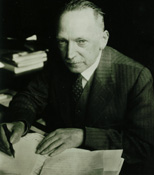
Friedländer 1927 / Friedländer 1969
Die altniederländische Malerei – 5. Band: Geertgen van Haarlem und Hieronymus Bosch (Max J. Friedländer) 1927
[Paul Cassirer, Berlin, 1927, pp. 79-130]
[English edition: Max J. Friedländer, Early Netherlandish Painting – Volume V: Geertgen tot Sint Jans and Jerome Bosch – Comments and notes by G. Lemmens. A.W. Sijthoff-La Connaissance, Leiden-Brussels, 1969, pp. 45-72 / 81-88 / 93 / 98-100]
[Also mentioned in Gibson 1983: 19 (A29 / A94)]
We quote the English edition.
In the foreword: Bosch worked in ’s-Hertogenbosch, a place that belonged to the duchy of Brabant, rather remote from the cultural centre of Holland.
The Life and Works of Jerome Bosch
Bosch is in every sense a master of the fifteenth century. Tody ’s-Hertogenbosch belongs to Holland but it cannot be accounted Dutch in a cultural sense, if we are at all entitled to speak of a Dutch cultural region as existing in the fifteenth century. No clear distinction is made between the works of Bosch and those of his imitators because it is the content of his pictures that arouses curiosity, leaving little interest in the examination of his forms and colours. The issue of authenticity should be based on five, rightly accounted originals showing the master’s full signature: the St Anthony triptych (Lisbon), the Epiphany triptych (Madrid), the St John on Patmos panel (Berlin), the St Julia triptych (Venice) and the Hermits triptych (Venice). Other important works can be found (in 1927!) in the Escorial.
Friedländer then discusses the works of Bosch according to their theme:
The last two groups were more popular in the sixteenth century and therefore better preserved. Because of this our view is distorted: the fantastic creations outnumber the others. A chronological approach is very difficult, which is why Friedländers prefers a thematical approach, although he does try to pay attention to the issue of chronology, with the help of stylistic analysis.
The Character of Jerome Bosch
Friedländer points out the danger of the historical method: ‘No sooner is every quality seen as a consequence, when innocence drops away from observation’. Circa 1550 there was a Bosch revival: Jan de Cock, Jan Mandyn, Gilles Mostaert, Frans Verbeeck, Pieter Huys, Herri met de Bles and most of all Peter Bruegel. Today ’s-Hertogenbosch is part of the region North Brabant, but that is of little use to the art historian (sic!). Bosch’s fondness of the grotesque that made fun of evil was already present in church gargoyles, in choir pew carvings and in manuscripts. Whatever Bosch’s own faith, he was a pessimist and above all an artist: the devil ruled but his dominion had lost its terror. Bosch was no portraitist: only the special case, the physiognomical curiosity, fascinated him. His teachers must have been provincial panel painters, perhaps book illustrators who left no lasting imprint on their student.
Drawings by Bosch and engravings after his compositions
Bosch’s artistic personality emerges far more clearly in his drawings than in his panels: in his drawings he was not inhibited by his patron’s wishes and he could give loose rein to his inspiration. A list of authentic drawings on pp. 68-69. A sharp distinction must be made between the group of engravings made during Bosch’s lifetime and those published by Hieronymus Cock between 1550-60. The first group claims greater interest, particularly the engravings of Alart du Hameel. There is also a third group of which another master may be considered to have been the inventor. A catalogue of Bosch’s paintings on pp. 81-88 and 91-93.
It is very difficult to summarize Friedländer’s analyses of the individual panels and drawings because of his vague, elusive style of writing. As Friedländer himself wrote in the foreword to his Von Eyck bis Bruegel (first edition in 1916, second enlarged edition in 1921, English translation and new edtion in 1956, Dutch translation in 1957): ‘Aphoristic remarks, put together unsystematically, are best suited to transmit pictorial impressions, to spotlight particular characteristics’ (edition 1956, reprint 1981, p. X).
[explicit]